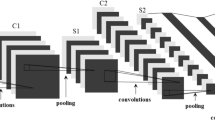Abstract
This paper presents an image restoration model based on the implicit function theorem and edge-preserving regularization. We then apply the model on the subband-coded images using the artificial neural network. The edge information is extracted from the source image as a priori nowledge to recover the details and reduce the ringing artifact of the subband-coded image. The multilayer perceptron model is employed to implement the restoration process. The main merit of the presented approach is that the neural network model is massively parallel with strong robustness for the transmission noise and parameter or structure perturbation, and it can be realized by VLSI technologies for real-time applications. To evaluate the performance of the proposed approach, a comparative study with the set partitioning in hierarchical tree (SPIHT) has been made by using a set of gray-scale digital images. The experimental results showed that the proposed approach could result in compatible performances compared with SPIHT on both objective and subjective quality for lower compression ratio subband coded image.
Similar content being viewed by others
References
H.J. Barnard, J.H.Weber, and J. Biemond, “A region-based discrete wavelet transform,” inProceedings VII European Signal Processing Conference, Vol. 2, Sept. 1994, pp. 1038–1041.
E.B.Baum and D. Haussler, “What size net gives valid generalization?” Neural Computation, Vol. 1, No. 1, pp. 150–160, 1989.
G.W. Cottrell, P. Munro, and D. Zipser, “Learning internal representation from grayscale images: Anexample of extensional programming,” in Proc. Of the 9th Annu. Conf. of the Cognitive Soc., 1987, pp. 462–473.
C. Cramer, E. Gelenbe, and H. Bakircioglu, “Low bit-rate video compression with neural networks and temporalsubsampling,” Proceedings of the IEEE, Vol. 84, No. 10, pp. 1529–1543, 1996.
K. Culik II and J.Kari, “Efficient inference algorithm for weighted finite automata,” in Fractal Image Encoding and Compression, Y. Fisher (Ed.), Springer-Verlag: New York, 1995.
K. Culik II and V. Valenta, “Finite automata basedcompression of bi-level images,” in Proceedings of Data Compression Conference, 1996, pp. 280–289.
N.J. DeLillo, Advanced Calculus with Applications, Macmillan Publishing Co., Inc.: USA, 1982.
R.D. Dony and S.Haykin, “Neural network approach to image compression,” Proceedings of the IEEE,Vol. 83, No. 2, pp. 288–303, 1995.
K.I. Funahashi, “On the approximate realization of continuous mappings by neural Networks,” NeuralNetworks, Vol. 1, No. 2, pp. 183–192, 1989.
M. Gilge, T. Engelhardt, and R. Mehlan, “Coding ofarbitrarily shaped image segments based on a generalized orthogonal transform,” Image Communication, Vol. 1, No. 2, pp. 153–180, 1989.
S.W. Hong and P. Bao, “Finite automata and regularized edge preserving wavelet transformscheme,” in IEEE Proceedings of Data Compression Conference, March, 1999.
S.W. Hong and P. Bao, “Hybridimage compression model based on subband coding and edge-preserving regularization,” IEE Proceedings—Vision, Image and Signal Processing, Vol. 147, No. 1, pp. 16–22, 2000.
S.W. Hong and P. Bao, “An edge preservingsubband coding model based on non-adaptive and adaptive regularization,” Image and Vision Computing, Vol. 18, No. 8, pp. 573–582, 2000.
A.K. Katsaggelos and R.M. Mersereau, “A regularized iterative image restorationalgorithm,” IEEE Transactions on Signal Processing, Vol. 39, No. 4, pp. 914–929, 1991.
M. Maillon,“Neural approach for television image compression using a Hopfield type network,” in Advances in Neural Information Processing Systems, Morgan-Kaufmann: New York, 1989, pp. 264–271.
A. Namphol, S.H. Chin, and M.Arozullah, “Image compression with a hierarchical neural network,” IEEE Transactions on Aerospace and Electronics Systems, Vol. 32, No. 1, pp. 326–338, 1996.
J. Paik and A. Katsaggelos, “Image restoration using amodified Hopfield network,” IEEE Transactions on Image Processing, Vol. 1, No. 1, pp. 49–63, 1992.
S. Perry and L. Guan, “Neural network restoration of images suffering space-variant distortion,” Electronics Letters,Vol. 31, No. 16, pp. 1358–1359, 1995.
S.A. Rizvi, L.C. Wang, and N.M. Nasrabadi, “Neural networkarchitectures for vector prediction,” Proceedings of the IEEE, Vol. 84, No. 10, pp. 1513–1528, 1996.
S.A. Rizvi, L.C. Wang, and N.M. Nasrabadi, “Nonlinear vector prediction using feed-forward neural networks,” IEEETransactions on Image Processing, Vol. 6, No. 10, pp. 1431–1436, 1997.
A. Said and W.A. Pearlman,“A new, fast, and efficient image codec based on set partitioning in hierarchical trees,” IEEE Transactions on Circuits and Systems for Video Technology, Vol. 6, No. 3, pp. 243–250, 1996.
J.M. Shapiro, “Embedded imagecoding using zerotrees of wavelet coefficients,” IEEE Transactions on Signal Processing, Vol. 41, No. 12, pp. 3445–3462, 1993.
G.L. Sicuranzi, G. Ramponi, and S. Marsi, “Artificial neural network for imagecompression,” Electronics Letters, Vol. 26, pp. 477–479, 1990.
D. Taubman and A. Zakhor,“Orientation adaptive subband coding of images,” IEEE Transactions on Image Processing, Vol. 3, No. 4, pp. 421–437, July 1994.
S. Teboul, L. Blanc-Feraud, G. Aubert, and M. Barlaud, “Variational approach for edge-preserving regularization using coupled PDE's,” IEEE Transactions on Image Processing, Vol. 7, No. 3, pp. 387–397, 1998.
M. Vetterli and J. Kovacevic, Wavelets and Subband Coding, Prentice-Hall, Inc.: Upper SaddleRiver, N.J., 1995.
B. Widrow and M.A. Lehr, “30 years of adaptive neural networks: Perceptron, Madaline, andbackpropagation,” Proceedings of the IEEE, Vol. 78, No. 9, pp. 1415–1442, 1990.
Y. Yang, N.P.Galatsanos, and A.K. Katsaggelos, “Regularized reconstruction to reduce blocking artifacts of block discrete cosine transform compressed images,” IEEE Transactions on Circuits and Systems for Video Technology, Vol. 3, No. 6, pp. 421–432, 1993.
A. Zakhor, “Iterative procedures for reduction of blocking effects in transform image coding,” IEEETransactions on Circuits and Systems for Video Technology, Vol. 2, No. 1, pp. 91–95, 1992.
Y. Zhou, R.Chellappa, A. Vaid, and B. Jenkins, “Image restoration using neural network,” IEEE Transactions on Acoust., Speech, Sig. Proc., Vol. 36, No. 7, pp. 1141–1151, 1988.
Author information
Authors and Affiliations
Corresponding author
Rights and permissions
About this article
Cite this article
Bao, P., Wang, D. An Edge-Preserving Image Reconstruction Using Neural Network. Journal of Mathematical Imaging and Vision 14, 117–130 (2001). https://doi.org/10.1023/A:1011207214916
Issue Date:
DOI: https://doi.org/10.1023/A:1011207214916




